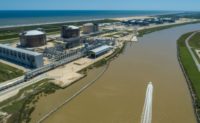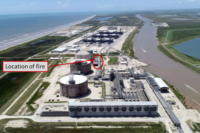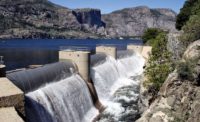Freeport LNG’s $13.5-billion natural gas liquefaction plant and export terminal in Texas, closed since a June 8 fire and explosion that damaged the facility, said it will not partially reopen until possibly mid-November, and not fully operate until next March—the third delay it has announced.
The Aug, 23 notice of another delay for the facility, which accounts for at least 15% of U.S. LNG exports, caused natural gas futures to fall more than 5%.
The Houston-based company also said it has hired Kiewit Construction will perform engineering, procurement and construction needed to restore operation of the plant on Quntana Island near Galveston.
A spokeswoman declined to provide any further detail on the contract value, scope of the contractor's work, reasons for the new delay or extent of the fire damage.
Freeport LNG said it has completed a detailed assessment of alternatives for resuming partial operations and has developed a recovery plan that “ensures the long-term safety and integrity of the facility and provides recovery execution certainty.”
The company also noted that typical construction risks could affect the recovery plan.
Freeport plans to use the plant’s second LNG loading dock to allow partial operations, which had been set for early October, to possibly reach 85% before year eend. Repairs to the damaged dock should be completed in March, allowing loading capabilities to reach 100% capacity of 2.1 billion cu ft per day. Full operation had been projected for December.
The company said Aug. 3 that it had entered into a consent agreement with the U.S. Transportation Dept.'s Pipeline Hazardous Materials Safety Administration, which it said would ensure that the plant can safely resume initial production and return to full operation.
The agency said a preliminary investigation revealed that conditions at the Freeport plant pose an integrity risk and issued a notice of proposed safety order that require remedial actions.
Operation of the LNG storage tanks, inspection and testing procedures for all control systems had to be evaluated along with assessment of worker qualifications and training.
“Continued operation of the export facility without corrective measures may pose an integrity risk to public safety, property or the environment,” the agency said.
The early evaluation said an isolated pressure safety valve created overpressure in 300 ft of vacuum insulated piping. The piping burst and allowed LNG and methane to escape, which caused the explosion and fire, the safety agency said. The company said at the time that operations would begin in September.
Freeport said it is coordinating closely with the pipeline agency, the Federal Energy Regulatory Commission, and others, including the U.S. Coast Guard, which earlier issued an order that restricts all marine cargo operations until Freeport conducts a risk analysis on marine transfers.
The three-train 15 million ton-per-year plant located south of Galveston is the second largest in the U.S. and also produces about 4% of global capacity. It began operating as an import terminal in 2008 and began exporting in 2019.
The company plans to add a fourth 5-million ton/year train with construction beginning in 2023 and in May asked FERC to extend the completion deadline until August 2028 from the current 2026 date to accommodate supply chain disruptions due to Covid-19.
The company said in a Federal Register filing that a normal 42-month construction schedule could now take between 48 and 56 months. It has all other necessary approvals for construction.
With the extent of current global needs, investments in new LNG infrastructure could reach $42 billion annually in 2024, research firm Rystad Energy said Aug. 24 in announcing new research.
Spending on approved greenfield LNG projects this year will total $27 billion and about $32 billion in 2023
"These greenfield investments are 20 times the amount in 2020 when just $2 billion was invested in LNG developments due to the pandemic," says the firm. "However, project approvals after 2024 are forecast to fall off a cliff as governments transition away from fossil fuels and accelerate investments in low-carbon energy infrastructure."






Post a comment to this article
Report Abusive Comment